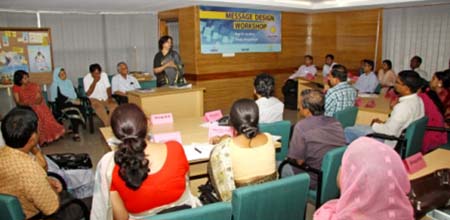USAID-DFIDNGO Health Service Delivery Project
 The project supports the delivery of essential service package (ESP) through a nationwide network consists of 25 national and local NGOs to provide health service deliveries through 399 static clinics, 10754 satellite clinics, 8316 Community Service Providers to serve about 26 million people (15% of the population) brings 42 million service contacts annually. The major mandate is to establish the ‘Smiling Sun’ or Surjer Hashi (SH) as a health brand as mark of quality service.
The project supports the delivery of essential service package (ESP) through a nationwide network consists of 25 national and local NGOs to provide health service deliveries through 399 static clinics, 10754 satellite clinics, 8316 Community Service Providers to serve about 26 million people (15% of the population) brings 42 million service contacts annually. The major mandate is to establish the ‘Smiling Sun’ or Surjer Hashi (SH) as a health brand as mark of quality service.
Objective
- Increased access to and use of the ESP, especially among poor women, young women, newborns, and under fives;
- Improved healthy behaviors and care seeking practices; and
- Enhanced ownership of service delivery by network NGOs.
BCCP is leading the BCC approaches and enhance NGO capacity to deliver quality BCC messages to generate demand, enhance service uptake, and promote healthy household practices such as IYCF, maternal nutrition, ENC, and recognition of and care seeking for ARIs. Central to our BCC approach is the concept of the household as a generator of its own health, reinforced by supportive, mobilized communities.
Enhanced BCC capacity: Using JHU-CCP’s Institutional Communication Assessment Tool (ICA), BCCP will conduct a rapid assessment of NGOs’ capacity to implement facility- and community-based BCC strategies. Findings will inform a results-oriented plan to systematically strengthen NGOs’ in-house capacity to plan, implement, monitor, and evaluate BCC activities that support ESP use and healthy household practices and social norms. BCCP will use a blended learning approach that includes capacity building workshops, targeted TA and mentorship, establishment of a Community of Practice, and an eLearning course.
Coordination, consensus, and communication strategy: BCCP will harness JHU-CCP’s leadership in the Bangladesh KM Initiative (BKMI), adopting and applying its gold standard of focused messaging and evidence-based tools. BCCP will harmonize and coordinate health messages with other BCC campaigns, including those under the purview of DGFP and DGHS and utilize existing templates, frameworks, and other national-level resources. The Project will develop a unified, evidence-based communication strategy to create an NGO package of communication resources for branding, demand generation, and BCC. BCCP will prioritize BCC efforts to build an environment of healthy practices and increased demand for ESP services; at the same time supporting NGOs’ planning, phased implementation, and M&E of BCC activities.
Promotion of key behaviors through multiple channels: BCCP will convene BCC strategy development workshops to design, with GOB input, multichannel FP/MNCH and nutrition communication campaigns tailored to urban and rural audiences. Utilizing and adapting existing BCC materials, including those developed by NSDP and SSFP, BCCP will reach rural audiences through social networks, CSPs, SPOs, radio listening groups, and folk theater. Urban audiences will be reached through CSPs, SPOs, mass media, and campaigns to positively influence decision makers. BCCP will explore a co-branding initiative to forge connections between SMC’s Blue Star Providers and the SH network to generate demand for ESP services. We will strengthen the linkages and coordination between facility- and community-based BCC activities by: 1) ensuring that facility-based providers, CSPs, SPOs, and community groups have harmonized BCC messages and materials; 2) using SHCSGs to enhance coordination; and 3) organizing service delivery-linked community BCC events. The Project will also support NGOs in creating linkages with a diverse range of community-based workers including Family Welfare Visitors, Agricultural Extension Workers, Health Assistants, and those working under USAID’s FTF, environmental, and democracy and governance projects to deliver BCC messages and generate demand among underserved groups. Based on experience, we anticipate some challenges in creating these multispectral linkages and we have preemptively identified appropriate solutions.
Monitoring and evaluation: Within NHSDP’s overall approach to M&E (Annex 2), BCCP will build NGO capacity to establish and sustain monitoring systems to assess the quality and effectiveness of BCC activities at the facility and community levels. Outcome monitoring, Most Significant Change, and observations of IPC/C using a checklist adapted from the Rotter Interaction Analysis Scale will be used to monitor specific aspects of BCC. IPC/C will also be monitored as part of broader efforts to monitor quality, including through mystery client visits and exit interviews. We will leverage the Demographic and Health Survey and SSFP end line as baseline data to evaluate the reach and impact of BCC interventions, supplemented by targeted assessments of key behavioral determinants to better understand the mechanisms of BCC because these psychosocial measures are not captured in the existing surveys. For additional BCC activities.
Expected Results from BCCP:
- Key messages in line with GOB guidelines are developed/adapted and disseminated through a wide array of channels, such as mass media, Smiling Sun and public sector clinical facilities, partnerships with other community-based organizations, community dissemination, social media, cell phones, and school-based programs.
- At least 80 percent of clinics have at least one service provider trained in IPC/C to include BCC messages while counseling on ESP interventions
- At least 80 percent of clinics implement monitoring systems (e.g. mystery client) to assess the quality of counseling services
- BCC strategies harmonized across communities and health facilities and with other USAID-supported health projects
- Healthy behaviors and care seeking practices are adopted among target client audiences.
